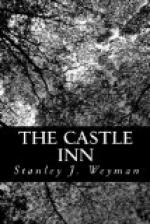Fortunately the Castle Inn, on the road between London and the west, was a place of call, not of residence. Formerly a favourite residence of the Seymour family, and built, if tradition does not lie, by a pupil of Inigo Jones, it stood—and for the house, still stands—in a snug fold of the downs, at the end of the long High Street of Marlborough; at the precise point where the route to Salisbury debouches from the Old Bath Road. A long-fronted, stately mansion of brick, bosomed in trees, and jealous of its historic past—it had sheltered William of Orange—it presented to the north and the road, from which it was distant some hundred yards, a grand pillared portico flanked by projecting wings. At that portico, and before those long rows of shapely windows, forty coaches, we are told, changed horses every day. Beside the western wing of the house a green sugarloaf mound, reputed to be of Druidical origin, rose above the trees; it was accessible by a steep winding path, and crowned at the date of this story by a curious summer-house. Travellers from the west who merely passed on the coach, caught, if they looked back as they entered the town, a glimpse of groves and lawns laid out by the best taste of the day, between the southern front and the river. To these a doorway and a flight of stone steps, corresponding in position with the portico in the middle of the north front, conducted the visitor, who, if a man of feeling, was equally surprised and charmed to find in these shady retreats, stretching to the banks of the Kennet, a silence and beauty excelled in few noblemen’s gardens. In a word, while the north front of the house hummed with the revolving wheels, and echoed the chatter of half the fashionable world bound for the Bath or the great western port of Bristol, the south front reflected the taste of that Lady Hertford who had made these glades and trim walks her principal hobby.
With all its charms, however, the traveller, as we have said, stayed there but a night or so. Those in the house, therefore, would move on, and so room could be made. And so room was made; and two days later, a little after sunset, amid a spasm of final preparation, and with a great parade of arrival, the earl’s procession, curricle, chariot, coaches, chaises, and footmen, rolled in from the west. In a trice lights flashed everywhere, in the road, at the windows, on the mound, among the trees; the




